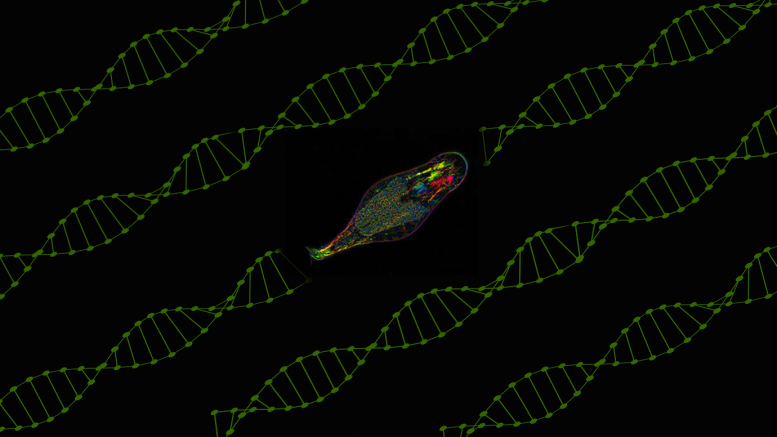
Scientists with the Marine Biological Laboratory discovered a new form of genetic modification in a tiny organism called a bdelloid rotifer (Adineta vaga, center, seen under a microscope). Credit: Microscope image courtesy of M. Shribak and I. Arkhipova
Marine Biological Laboratory finds gene captured from bacteria more than 60 million years ago.
Your DNA holds the blueprint to build your body, but it’s a living document: Adjustments to the design can be made by epigenetic marks. Cataloguing these marks and how they work is important for understanding biology and genetics—and coming up with therapies to address diseases and disorders.
In humans and our fellow eukaryotes, two principal epigenetic marks are known. But a team from the University of Chicago-affiliated Marine Biological Laboratory has discovered a third, novel epigenetic mark—one formerly known only in bacteria—in small freshwater animals called bdelloid rotifers.
This fundamental and surprising discovery was reported on February 28, 2022, in Nature Communications.
“We discovered back in 2008 that bdelloid rotifers are very good at capturing foreign genes,” said senior author Irina Arkhipova, senior scientist in the Marine Biological Laboratory’s Josephine Bay Paul Center. “What we’ve found here is that rotifers, about 60 million years ago, accidentally captured a bacterial gene that allowed them to introduce a new epigenetic mark that was not there before.”
‘Jumping genes’
Epigenetic marks are modifications to DNA bases that don’t change the underlying genetic code, but “write” extra information on top of it that can be inherited along with your genome. Epigenetic marks usually regulate gene expression by turning genes on or off, particularly during early development or when your body is under stress. They can also suppress transposons, or “jumping genes” that may threaten the integrity of your genome.
This discovery marks the first time that a horizontally transferred gene—that is, a gene acquired from another organism not through sexual reproduction—has been shown to reshape the gene regulatory system in a eukaryote.
“This is very unusual and has not been previously reported,” Arkhipova said. “Horizontally transferred genes are thought to preferentially be operational genes, not regulatory genes. It is hard to imagine how a single, horizontally transferred gene would form a new regulatory system, because the existing regulatory systems are already very complicated.”
“It’s almost unbelievable,” said co-first author Irina Yushenova, a research scientist in Arkhipova’s lab.
Yushenova explained how this process would have occurred: “Just try to picture, somewhere back in time, a piece of bacterial DNA happened to be fused to a piece of eukaryotic DNA. Both of them became joined in the rotifer’s genome and they formed a functional enzyme. That’s not so easy to do, even in the lab, and it happened naturally. And then this composite enzyme created this amazing regulatory system, and bdelloid rotifers were able to start using it to control all these jumping transposons. It’s like magic.”
Transposons, a term for genes that move around from one place to another inside your genome, can change genetic code for the better or worse, so keeping them in check is very important.
“You don’t want transposons jumping around in your genome,” said the study’s first author, Fernando Rodriguez, also a research scientist in Arkhipova’s lab. “They will mess things up, so you want to keep them in check. And the epigenetic system to accomplish that is different in different animals. In this case, a horizontal gene transfer from bacteria into bdelloid rotifers created a new epigenetic system in animals that hasn’t been described before.”
“Bdelloid rotifers, especially, have to keep their transposons in check because they primarily reproduce asexually,” Arkhipova said. “Asexual lineages have fewer means for suppressing proliferation of deleterious transposons, so adding an extra layer of protection could prevent a mutational meltdown. Indeed, transposon content is much lower in bdelloids than it is in sexual eukaryotes that don’t have this extra epigenetic layer in their genome defense system.”
In the two previously known epigenetic marks in eukaryotes, a methyl group is added to a DNA base, either cytosine or adenine. The team’s newly discovered mark is also a cytosine modification, but with a distinct bacterial-like positioning of the methyl group—essentially recapitulating evolutionary events of over two billion years ago, when the conventional epigenetic marks in early eukaryotes emerged.
Dessication and discovery
Bdelloid rotifers are extremely resilient animals, as the Arkhipova and David Mark Welch labs at MBL have discovered over the years. They can completely dry up for weeks or months at a time, and then spring back to life when water becomes available. During their dry phases, their DNA breaks up into many pieces.
“When they rehydrate or otherwise render their DNA ends accessible, this might be an opportunity for foreign DNA fragments from ingested bacteria, fungi, or microalgae to transfer into the rotifer genome,” Arkhipova said. About 10 percent of the rotifer genome comes from non-metazoan sources, they have found.
Still, the Arkhipova lab was surprised to find a gene in the rotifer genome that resembled a bacterial methyltransferase (a methyltransferase is a kind of molecule that catalyzes the transfer of a methyl group to DNA). “We hypothesized that this gene conferred this new function of suppressing transposons, and we spent the last six years proving that, indeed, it does,” Arkhipova said.
It’s too early to know what the implications may be of discovering this new epigenetic system in rotifers. But parallel discoveries have had major impacts on biology.
“A good comparison is the CRISPR-Cas system in bacteria, which started out as a basic research discovery. Now CRISPR-Cas9 is used everywhere as a tool for gene editing in other organisms,” Rodriguez said. “This is a new system. Will it have applications, implications for future research? It’s hard to tell.”
Reference: “Bacterial N4-methylcytosine as an epigenetic mark in eukaryotic DNA” by Fernando Rodriguez, Irina A. Yushenova, Daniel DiCorpo and Irina R. Arkhipova, 28 February 2022, Nature Communications.
DOI: 10.1038/s41467-022-28471-w
Funding: National Institutes of Health
The Marine Biological Laboratory is dedicated to scientific discovery – exploring fundamental biology, understanding marine biodiversity and the environment, and informing the human condition through research and education. Founded in Woods Hole, Massachusetts in 1888, the MBL is a private, nonprofit institution and an affiliate of the University of Chicago.

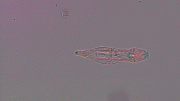
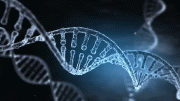
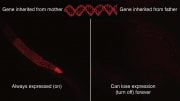
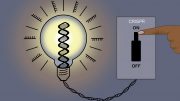
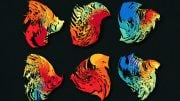
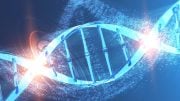
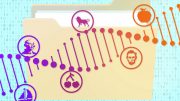
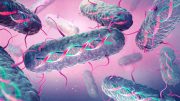
Babu G. Ranganathan*
(B.A. Bible/Biology)
HOW DOES DNA TURN A CELL INTO A SHEEP, OR A BIRD, OR A HUMAN?
When you divide a cake, the cake never gets bigger. However, when we were just a single cell and that cell kept dividing we got bigger. New material had to come from somewhere. That new material came from food.
Just as the sequence of various letters and words in human language communicate a message and direct workers to build and assemble something so, too, the sequence of various molecules in our DNA (our genes or genetic code) directed molecules (i.e. various amino acids, the building blocks of proteins) from our mother’s food, that we received in the womb, to become new cells, eventually forming all the tissues and organs of our body. Food isn’t just for energy. It’s also material used by the body to make new cells. After all, when we eat meat or vegetables we’re actually eating cells of animals and plants.
When you feed a cat your food the cat’s DNA will direct the food molecules to become the cells, tissues, and organs of a cat, but your DNA will turn the same food into human cells, tissues, and organs.
What we call “genes” are actually segments of the DNA molecule. When you understand how your DNA works, you’ll also understand how egg yolks can turn into chickens. Read my popular Internet article: HOW DID MY DNA MAKE ME? Just google the title to access the article.
This article will give you a good understanding of how DNA, as well as cloning and genetic engineering. You also learn that so-called “Junk DNA” isn’t junk at all. You will learn why it is not rational to believe that DNA code could have arisen by chance. Science points (not proves, but points) to an intelligent cause for DNA code.
What about genetic and biological similarities between species? Genetic information, like other forms of information, cannot happen by chance, so it is more logical to believe that genetic and biological similarities between all forms of life are due to a common Designer who designed similar functions for similar purposes. It doesn’t mean all forms of life are biologically related! Only genetic similarities within a natural species proves relationship because it’s only within a natural species that members can interbreed and reproduce.
Nature cannot build DNA code from scratch. It requires already existing DNA code to direct and bring about more DNA code or a genetic engineer in the laboratory using intelligent design and highly sophisticated technology to bring DNA code into existence from scratch. Furthermore, RNA/DNA and proteins are mutually dependent (one cannot come into existence without the other two) and cannot “survive” or function outside of a complete and living cell. DNA code owes its existence to the first Genetic Engineer – God!
Protein molecules require that various amino acids come together in a precise sequence, just like the letters in a sentence. If they’re not in the right sequence the protein won’t function. DNA and RNA require for various their various nucleic acids to be in the right sequence.
Furthermore, there are left-handed and right-handed amino acids and there are left-handed and right-handed nucleic acids. Protein molecules require for all their amino acids to be left-handed only and in the right sequence. DNA and RNA require for all their nucleic acids to be right-handed and in the right sequence. It would take a miracle for DNA, RNA, and proteins to arise by chance!
Mathematicians have said any event in the universe with odds of 10 to 50th power or greater is impossible! The probability of just an average size protein molecule (with its amino acids in the right sequence) arising by chance is 10 to the 65th power. Even the simplest cell is made up of many millions of various protein molecules along with and DNA/RNA..
The late great British scientist Sir Frederick Hoyle calculated that the odds of even the simplest cell coming into existence by chance is 10 to the 40,000th power! How large is this? Consider that the total number of atoms in our universe is 10 to the 82nd power.
Also, so-called “Junk DNA” isn’t junk. Although these “non-coding” segments of DNA don’t code for proteins, they have recently been found to be vital in regulating gene expression (i.e. when, where, and how genes are expressed, so they’re not “junk”). Also, there is evidence that, in certain situations, they can code for proteins through the cell’s use of a complex “read-through” mechanism.
Visit my latest Internet site: THE SCIENCE SUPPORTING CREATION (This site answers many arguments, both old and new, that have been used by evolutionists to support their theory)
Author of the popular Internet article, TRADITIONAL DOCTRINE OF HELL EVOLVED FROM GREEK ROOTS
*I have given successful lectures (with question and answer period afterwards) defending creation before evolutionist science faculty and students at various colleges and universities. I’ve been privileged to be recognized in the 24th edition of Marquis “Who’s Who in The East.”